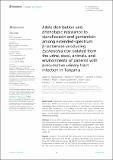Allele distribution and phenotypic resistance to ciprofloxacin and gentamicin among extended spectrum β-lactamases producing Escherichia coli from urine, stool, animals and environments of patients with presumptive urinary tract infection in Tanzania
Abstract
Background: Additional antimicrobial resistance to extended spectrum β-lactamases (ESBL)-producing E. coli exhausts treatment options. We investigated allele distribution and resistance to ciprofloxacin and gentamicin among ESBL-producing E. coli isolates from urine, stool, animals and environments of presumptive urinary tract infection (UTI) patients, in order to gain a crucial insight towards devising prevention and control measures, and treatment guidelines. Methods: Archived ESBL-producing E. coli isolates from urine, stool, animals and surrounding environments of presumptive UTI patients were retrieved. Antimicrobial susceptibility profiles to ciprofloxacin and gentamicin were done followed by multi-plex PCR for blaCTX-M, blaTEM and blaSHV, to determine ESBL alleles distribution. Data were analysed using STATA version 17. Results: A total of 472 confirmed ESBL-producing E. coli isolates from Mwanza 243 (51.5%), Kilimanjaro 143 (30.3%) and Mbeya 86 (18.2%) were analyzed. Of these, 75 (15.9%) were from urine, 199 (42.2%) from stool, 58 (12.3%) from rectal/cloaca swabs of animals and 140 (29.7%) from surrounding environments. Out of 472 ESBL producing E. coli, 98.9% (467) had at least one ESBL allele. The most frequent allele was blaCTX-M detected in 88.1% (416/472) isolates, followed by blaTEM allele detected in 51.5% (243/472) isolates. There were 40.7% (192/472) isolates harboring dual blaCTX-M + blaTEM alleles, and only 0.2% (1/472) isolate had dual blaCTX-M + blaSHV alleles whereas 2.3% (11/472) isolates had a combination of all three alleles (blaCTX-M + blaTEM + blaSHV). None of the isolates harbored a combination of blaTEM + blaSHV only. Resistance to ciprofloxacin and gentamicin was observed in 70.8% (334/472) and 46.0% (217/472) isolates, respectively. There was a significant difference in distribution of resistance to ciprofloxacin as well as to gentamicin among ESBL-producing E. coli isolated from various sources (p-value < 0.001 and 0.002, respectively. Conclusion: Almost all ESBL-producing E. coli isolates carry blaCTX-M, blaTEM and blaSHV either alone or in combination with the most common alleles being blaCTX-M. The resistance to cipropfloxacin and gentamicin which are front-line antibiotics for UTIs among ESBL producing E. coli is high. This implies the need to continuously revise the local guidelines used for optimal empirical therapy for UTI and continual surveillance using one health approach.
Citation
Mwakyoma , A A , Kidenya , B R , Minja , C A , Mushi , M F , Sandeman , A F , Sabiiti , W , Holden , M & Mshana , S E 2023 , ' Allele distribution and phenotypic resistance to ciprofloxacin and gentamicin among extended spectrum β-lactamases producing Escherichia coli from urine, stool, animals and environments of patients with presumptive urinary tract infection in Tanzania ' , Frontiers in Antibiotics , vol. 2 , 1164016 . https://doi.org/10.3389/frabi.2023.1164016
Publication
Frontiers in Antibiotics
Status
Peer reviewed
Type
Journal article
Description
Funding: This study was funded by the Holistic Approach to Unravel Antibacterial Resistance in East Africa (HATUA) project funded by the National Institute for Health Research, Medical Research Council, and the Department of Health and Social Care, Award (MR/S004785/1).Collections
Items in the St Andrews Research Repository are protected by copyright, with all rights reserved, unless otherwise indicated.

